3 min read
NAFO Report Highlights Part 1: U.S. Timberland Ownership and Classes
Hannah Jefferies : June 3, 2016
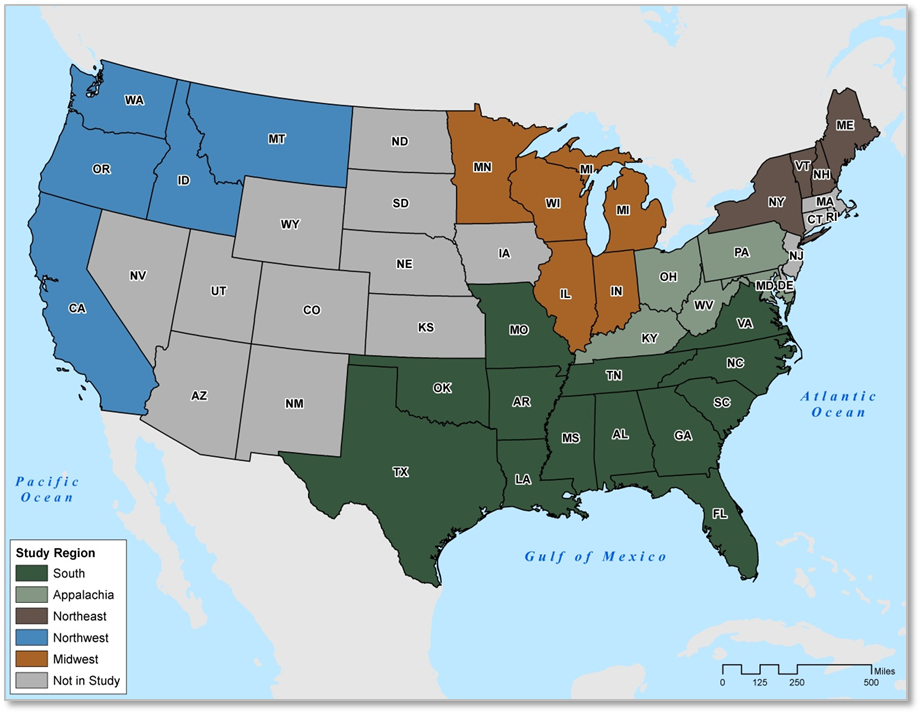
Forest2Market recently completed an economic impact study for the National Alliance of Forest Owners (NAFO). The study quantifies the contribution that forestry-related industries make to state, regional and national economies, and analyzes the most forested regions of the United States based on the most recent year of data available, which is 2013. The following map identifies the regions that were the subject of the study.

Regional Timberland Ownership Profiles
Of the 1.2 billion acres of land[1] in the study area, 564.2 million acres (45 percent) are forested. Most (81 percent) of this forested land is timberland; 19 percent is unproductive forestland. Timberland covers 457.8 million acres (37 percent) of the study area, and 46 percent of this timberland is located in the South, which also contains 48 percent of all forested land.
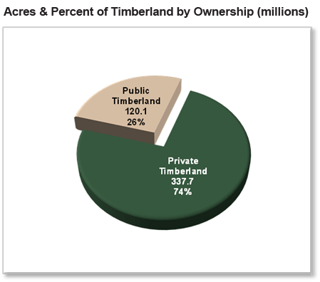
As a whole, 74 percent of timberland in the study area is owned by private entities, such as Timberland Investment Management Organizations (TIMOs), Real Estate Investment Trusts (REITs), corporate entities and private landowners. Roughly 54 percent of privately-owned timberland in the study area is located in the South. Regionally, the Northeast and South have the highest percentages of private ownership at 90 percent and 87 percent, respectively. Appalachia has a slightly lower percentage of private ownership at 84 percent, and 66 percent of timberland is privately-owned in the Midwest. Only 37 percent of timberland in the Northwest is privately-owned.
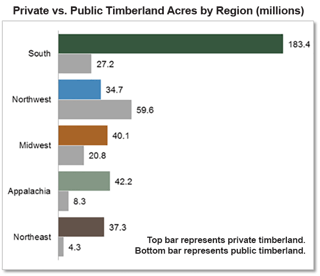
The table below shows the total timberland acres, privately-owned acres, publicly-owned acres and the percent private vs. public acres by state. In the South, Georgia has the highest number of private timberland acres at nearly 22.2 million while Oklahoma has the fewest at just under 6.4 million acres. Alabama has the highest percentage of privately-owned timberland acres at 94 percent and the second highest number of private acres (21.4 million). Florida has the lowest rate of private ownership at 71 percent and the second fewest private acres at just under 11 million.
In the Appalachian region, Pennsylvania has the most private timberland acres (11.9 million), and Maryland has the fewest (1.8 million). At 90 percent, Kentucky has the highest percentage of privately-owned timberland while Pennsylvania has the lowest percentage at 73 percent.
In the Northeast, Maine has both the most private acres (16.2 million) and the highest percentage of private ownership (95 percent). New Hampshire has the fewest private acres (3.5 million) and the lowest private ownership rate (77 percent).
In the Pacific Northwest, Oregon’s nearly 9.4 million acres make it the most prolific for private ownership, but Washington is a close second at almost 9.3 million acres of private timberland. At 52 percent, Washington has the highest rate of private ownership in this region. Idaho has the lowest at 17 percent.
In the Midwest, Illinois and Indiana have the fewest private timberland acres at around 4.1 million acres each. However, they also have the highest rates of private ownership in this region at 88 percent and 86 percent, respectively. Michigan has 12.5 million privately-owned timberland acres, which is the highest in this region. Minnesota has the lowest rate of private ownership at 49 percent.
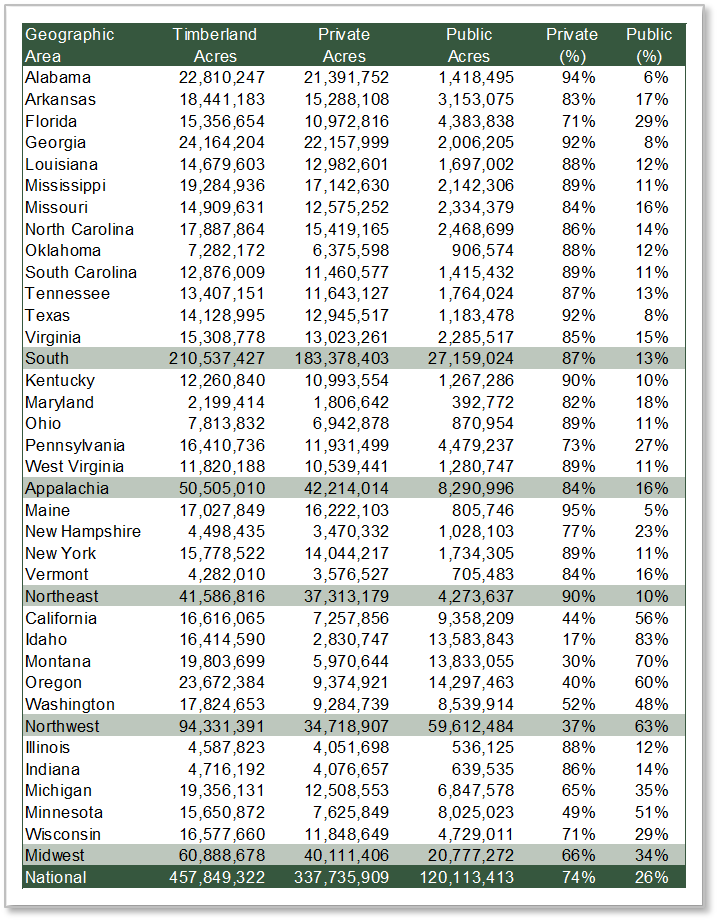
Regional Timberland Class Profiles
The map below, which is adapted from a U.S. Forest Service map, shows the types of forests that predominate in the contiguous (Lower 48) states. Conifer (softwood) species are commonly used in manufacturing lumber, plywood, panels, paper and paperboard. Hardwood species are commonly used for making furniture, flooring, veneer, millwork, pallets and printing grades of paper.
Softwood forest types, such as Loblolly/Shortleaf Pine and Longleaf/Slash Pine, predominate in the coastal plain regions of the South, while the Oak/Hickory hardwood forest type is more common in the northern, more mountainous areas. The Oak/Hickory forest type continues into Appalachia where scattered pockets of the Maple/Beech/Birch hardwood forest type also occur.
Extending north from Appalachia, the Maple/Beech/Birch hardwood forest type dominates the Northeast where the softwood Spruce/Fir forest type also occurs. Like the Northeast, the Midwest is a mixture of hardwood forest types, including Aspen/Birch and Maple/Beech/Birch, and softwood forest types, such as White/Red/Jack Pine and Spruce/Fir. Some scattered areas of Oak/Hickory exist in the lower Midwest.
Due to differences in climate and elevation, forest types in the Pacific Northwest vary from those in the other regions. The most common forest types are the softwood species of Douglas-fir, Fir/Spruce/Mountain Hemlock, Hemlock/Sitka Spruce, Ponderosa Pine and Mixed Conifer.
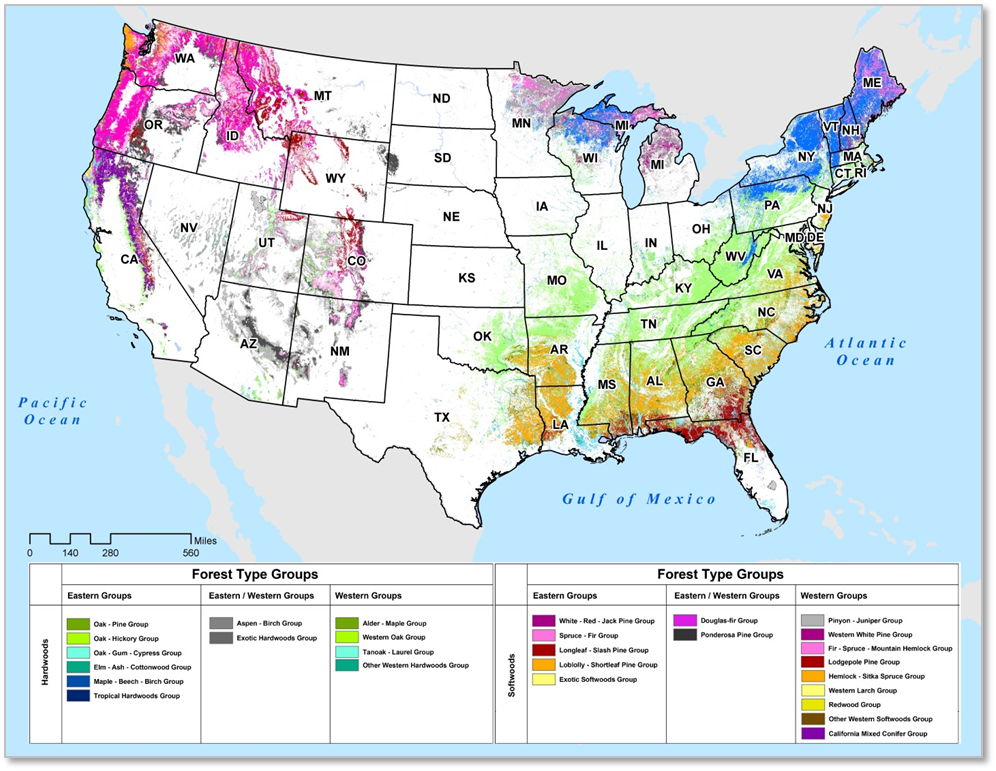
Read the full study and use the interactive state data feature on NAFO's website.
[1] Total land area in the study area is 1,244,803,523 acres. This excludes water.





